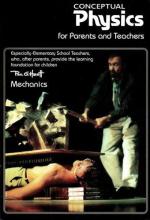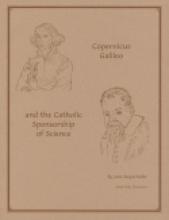No name
Come to Jesus! A Kid’s Book for Eucharistic Adoration
Common Ground
Conceptual Physics for Parents and Teachers, Book One: Mechanics
The Conceptual Physics series is designed to make scientific concepts more accessible to parents and teachers. The hope is that a greater understanding on our part will lead to more and better information for children at a young age so that they might begin to develop an interest in science and the wonders of the world around them. The author explains that the current emphasis in education seems to be on the process of how we came to understand certain things and that many students leave school without understanding basic concepts of gravity, motion, etc. His book is an attempt to remedy that situation.
I think the author does a commendable job at fulfilling this task. Although he introduces readers to the mathematical expressions used to describe certain concepts, his emphasis is on helping the reader to understand the concepts themselves. Mr. Hewitt has given the book a great deal of personality. Rather than being very "textbook-like", studying the book has more of the feel of going through the basics with a good highschool teacher – humor, interesting tidbits, etc. His explanations, profuse "real-life examples" and an ability to anticipate common misunderstandings do make these concepts accessible. I'm not going to pretend that working your way through this book is a breeze. For a rather non-scientific person like myself it required a bit of determination, particularly in getting started. However, once I got into the book a bit, I found it both engaging and interesting. The author clearly wants to make you think rather than simply filling you head with information. At one point he even mentions that "Good teaching isn't providing answers–it's asking good questions." Like any good teacher, he challenges you while keeping you interested. There are little question and answer sections scattered through the text to ensure that you're staying on track (I'm happy to say that I was able to answer most of these correctly). I especially enjoyed the experiments. They are simple enough to try at a moment's notice and even my children, who are ages six and under, were delighted to try them out with me. These experiments led to a lot of "ooh"s and "wow"s and some good discussions around the dinner table. Clearly, in my family, the aim of the author was accomplished.
The book covers a substantial quantity of information, including the following concepts: equilibrium, vectors, tension, motion, speed, velocity, acceleration, free-fall, mass, weight, force, friction, pressure, momentum, bouncing, energy, work, power, efficiency, rotational motion, torque, center of gravity, stability, and gravity. He frequently relates these concepts to interesting, "real-life" situations such as calculating the "hang-time" of basketball players, explaining how people can walk on broken glass or lie on a bed of nails without getting hurt, why long poles help tightrope walkers balance, how gravity causes tides and even a bit about black holes. Obviously this is a lot of material to cover in a book of 179 pages. He doesn't explain the entire history of how we've come to understand each concept, but focuses on helping the student understand how these concepts work based on scientific research to date. Anyone who studies the book will have a much greater understanding of physics than the average American. For some this may even be a springboard for a much greater interest in Science.
The only real problem I had with the technical chapters of the book (1 – 8) is a slightly belittling tone the author takes toward Aristotle. It comes in the context of Galileo and Newton's advances in understanding motion which revolutionized the beliefs of their day which had originated with Aristotle. I think it's largely due to his informal style and probably not intentional, but I think it's a point worthy of mention. I want to instill in my children a respect for the great thinkers of the past. It's easy for us today to become arrogant about our technological advances, but I think we need to remember how much of our progress today would have been impossible without those who preceeded us.
The final chapter (9) is entitled "On Science." Here the author presents some of his philosophies about what science is. He also makes some very useful distinctions about the meanings of words in a scientific context as compared to "ordinary speech". I thought his explanations about the attitudes required of a good scientist were very helpful. There is a lot of very good food for thought in this chapter and some particularly excellent quotes. One of my favorites was, "In your education it is not enough to be aware that other people may try to fool you; it is more important to be aware of your own tendency to fool yourself." (People would do well to consider that idea in any profession!) I was impressed with his sincerity and surprised by how well he presented the idea of the complementarity of science and religion (for a secular text). This was particularly enhanced by a quote of Einstein's he includes: "Science without religion is deaf; religion without science is blind." We Catholics aren't afraid of science. We believe that faith and reason work together. (An abundance of excellent reading material on this topic can be found on the Internet. I recommend the website: Creation, Creationism and Empirical Theistic Arguments and Pope John Paul II's encyclical On Faith and Reason (Fides et Ratio).)
Unfortunately I found some areas of the last chapter where the author goes beyond the realm of his expertise and includes some statements which lack the clarity present in most of his text. I think that he muddles some points by using controversial subjects as examples. Also expect a few "off-the-wall" comments such as "Truth is a word seldom used in science (it seems to me that those who say they seek only 'the truth' are more often seeking confirmation of what they already hold as true, and anything found that contradicts rather than supports, is discarded)" (p. 165), and, "It was then that I learned that right and wrong are relative terms. By definition, we're right and they're wrong. Few of us question what we've been taught to believe" (p. 166).
In good-natured curiosity then, if right and wrong are relative terms and science does not concern itself with the truth, how can the author be so sure that Aristotle was wrong?
You can read more about this title on the Focus Publishing Website.
black and white illustrations and photos
Confusion by Cupid
Since this is the third book in this series I suggest that it be read after the first two to provide maximum effect.
Reviewer 8th grade homeschooler
Connecting with History Vol. I
Conversational Latin for Oral Proficiency
The chapters are designed so that they need not be done in a particular order so that readers can jump to a topic of particular interest and gain some depth in their Latin studies by practicing pronunciation, memorizing conversational phrases, creating Latin-language skits or just "messing around" with the language a bit. The book includes plenty of ancient terms as well as words for modern ideas and inventions, so you won't have any trouble discussing everything from weather to the Internet during Latin class.
There are some really neat extras as well. The "Days, Weeks, Months and Years" segment gives some fascinating details on the calendar and time-telling used by the Romans. The "Grammar" chapter, which is particularly extensive, gives plenty of content for teachers wishing to conduct their entire Latin classes in Latin. There are also conversational pieces which would be great for memory work (with a question and answer format), for example: "What is a verb?" and "Give examples of a relative pronoun." (This segment, even if studied only in English, makes excellent review work as well.)
The topics covered are as follows: "Greetings:, "Family", "House and Furniture", "Daily Activities", "Sports and Other Leisure Activities", "The Human Body" (like a normal dictionary, proper names for body parts are included) , "Health and Physical Fitness", "Food and Drink", "Days, Weeks, Months, Years", "Expressions of Time", "Useful Colloquial Expressions", "Clothing and Jewelry", "School", "Buying and Selling", "The Weather", "Animals", "Emotions and Qualities", "Trades and Professions", "The City and Public Buildings", "Government", "War and Peace", "Law and Criminal Justice", "Geography and Topography", "Transportation" and "Grammar". Appendices include "Yes and No in Latin", "Colors", "Numbers", "Proverbs and Sayings", "Computer Terms" and a 137 page General Vocabulary arranged English to Latin.
Cookies: Bite-Size Life Lessons
Copernicus, Galileo and the Catholic Sponsorship of Science
The Galileo controversy is a big issue for Catholics and non-Catholics alike. Any number of resources commonly used by Catholic homeschoolers (such as Protestant high school science texts, certain biographies, novels, and many more) will portray this issue incorrectly. Homeschool parents teaching their children about faith and reason and homeschool students preparing to go out into the "real world" cannot afford to be clueless about this issue. I highly recommend this resource.
Copybook: First Year
Memoria Press' new copybooks provide a brilliantly simple combination of handwriting practice and memory work (simple Bible verses and classic poems from authors such as Robert Louis Stevenson). The child first practices simple letters before getting into Bible passages and poetry. These lessons also include space for illustrating the verse (great for reading comprehension!). Bible passages are taken from the King James Version of the Bible. Though the King James Bible does not suffice for Catholic religious instruction, it is rightly valued for its literary qualities and contributions to the English language. The Bible passages selected, which include passages important to Catholics like "I am the Bread of Life," are completely unobjectionable.








